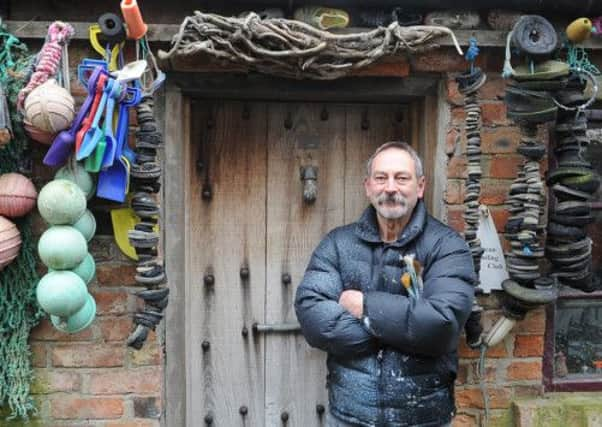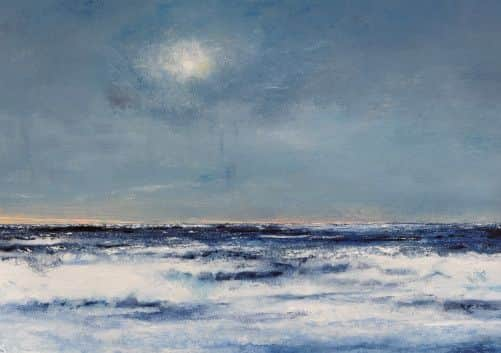Artist catches a rising tide


John Thornton doesn’t need to announce he has an interest in the sea. His house says it all.
For a start it’s called the Crow’s Nest and, while the property is some miles from the coast, the shed in his courtyard garden is adorned with fishing nets, glass floats and interesting pieces of flotsam and jetsam.
Advertisement
Hide AdAdvertisement
Hide Ad“My wife Deb says I should call it The Studio,” says John bundled against the unseasonal spring temperatures in a navy, paint spattered anorak. “but it’s The Shed – I’ve always worked in it.”


His parents bought the property in Selby in 1953, yet even in the kitchen, with its sturdy hand-crafted cupboards and solid farmhouse table, the influence of the sea is clear with its life size sculpture of black tailed godwits. John carved them from chunks of driftwood and fashioned their beaks and legs from corroded metal rods found on his beachcombing forays. “From the reinforced concrete coastal defences from the Second World War,’ he explains.
Elsewhere there are his seascapes worked in a combination of watercolour, ink and acrylic, so why the fascination?
“I can’t swim, but I’ve always loved the sea – yet I’m very funny about water. You won’t get me on a lake – I find still waters flat and dead and the only time I’ll paint still water is in woodland for reflection. But the sea – when it’s rough and broiling – I’ll be on it.”’
Advertisement
Hide AdAdvertisement
Hide AdJohn’s passion for painting emerged relatively late in life after he had spent much of his working life as a joiner just like his father and grandfather.
“When I left school at 15, I would have like to have gone to art college, but in 1960 it was the real world and Mum and Dad were still boss. I did what they said I should do, which was an apprenticeship. By the time I finished at 21, my outlook had changed, my sights were elsewhere – the Sixties were a very exciting time. I was drawn into them like a nail to a magnet and the art college thing was forgotten about until I was in my fifties.”
In the heady days of the late Sixties, John moved to London’s Notting Hill Gate and made a living making clothes, capitalising on the fashion for American Indian leather clothing, which he sold on Kings Road, Chelsea. Then followed two summer seasons working in Cornwall where he embraced the hippy community and lived barefoot amid the sand dunes.
In the mid-Seventies John made his way back to Yorkshire.
“My grandparents had died,” says. “This part of the house was vacant, so I moved in, but not to settle. I bought a Dormobile van and travelled round Morocco, visiting Agadir, Casablanca and Marrakesh.”
Advertisement
Hide AdAdvertisement
Hide AdAdventures over, John returned and settled down to work and bring up a family in his beloved Yorkshire.
“I think that Yorkshire people are the warmest in England, but they can be very stubborn and determined. Yorkshire is male and female – the gentleness of the Wolds – the masculine harshness of the moors. Maybe that stubborn determination that seems bred into us is what brings out the creative side – think about Judi Dench, Alan Bennett, Ted Hughes and the amazing coal miner artists. And we have Hockney in Bridlington.My wife and I came across his trees one day – near a little village called Warter – that’s when you realise that he has captured the scene – he can really paint.
“I don’t really know what inspired me to start painting again but one day, I did and enjoyed it. Friends encouraged me and that’s when I entered the Hull Open Art Exhibition. I submitted a couple of paintings and when I rang to arrange to collect my work, I was told that they had both sold and I was joint prize winner, which was such an encouragement.”
Just before his 60th birthday, John had secured a three or four exhibitions. By then the building trade was getting harder, so he decided to retire and paint full time.
Advertisement
Hide AdAdvertisement
Hide AdEncouraged by Ann Petherick of Kentmere House gallery in York, in 2003 John entered the annual exhibition at the prestigious Society of Marine Artists in London. The quality of his work was such he was accepted three years running.
“It was such a buzz exhibiting in the Society’s gallery on the Mall,” he says. “What with ‘Liz’s house’ down the road. I was just John the builder – the thought of anything like that was beyond my wildest dreams.”
John hasn’t stopped since and his shed is an Aladdin’s cave of beachcombing booty which may make its way one day onto a painting or sculpture.
“I think the hardest thing with a painting is starting,” he says. “You have this big block of white in front of you – it’s knowing where to put the first mark. I never know how it’s going to turn out.”
Advertisement
Hide AdAdvertisement
Hide AdOn larger works he adds collage from his flotsam and jetsam to exaggerate the texture and create relief. “After all,” he says, “on a beach nothing is flat is it? The sea will be churning, the beach moving.
“When I sell a painting, more important than the money is the thought that someone parts with their hard earned cash to buy something I’ve produced. Some people buy art because they think at some point it will make them some money. You should buy art because you like it.”
John’s work can be seen at Kentmere House Gallery, York until May 30 and at the Zillah Bell Gallery, Thirsk from June 28 to July 20 in the open exhibition From Saltburn to Spurn Point.